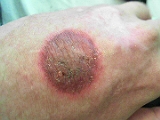| aerosol frostbite of the skin | |
|---|---|
| Other names | Aerosol-induced frostbite |
 | |
| Aerosol frostbite to the hand | |
| Specialty | Emergency medicine |
An aerosol frostbite of the skin is an injury to the body caused by the pressurized gas within an aerosol spray cooling quickly, with the sudden drop in temperature sufficient to cause frostbite to the applied area. [1] Medical studies have noted an increase of this practice, known as "frosting", in pediatric and teenage patients. [2] [3]
Contents
- Signs and symptoms
- Causes
- Unintentional
- Intentional and abuse
- Treatment
- See also
- References
- External links
Adiabatic expansion and/or evaporative cooling (with a low boiling temperature) causes the gas to rapidly cool on exit from the aerosol applier. In freeze sprays, a controlled amount of this cooling is useful. Uncontrolled cooling, however, can result in freeze burns to the skin. According to controlled laboratory experiments, the gas from a typical deodorant spray can is able to reduce skin temperature by up to sixty degrees Celsius. [2]
The form of injury is freezing of the skin, a type of frostbite. It is highly advised for those who develop frostbite to seek medical attention. [4]
In rare cases aerosol-induced burns can be severe enough to necessitate skin grafting. [5]
